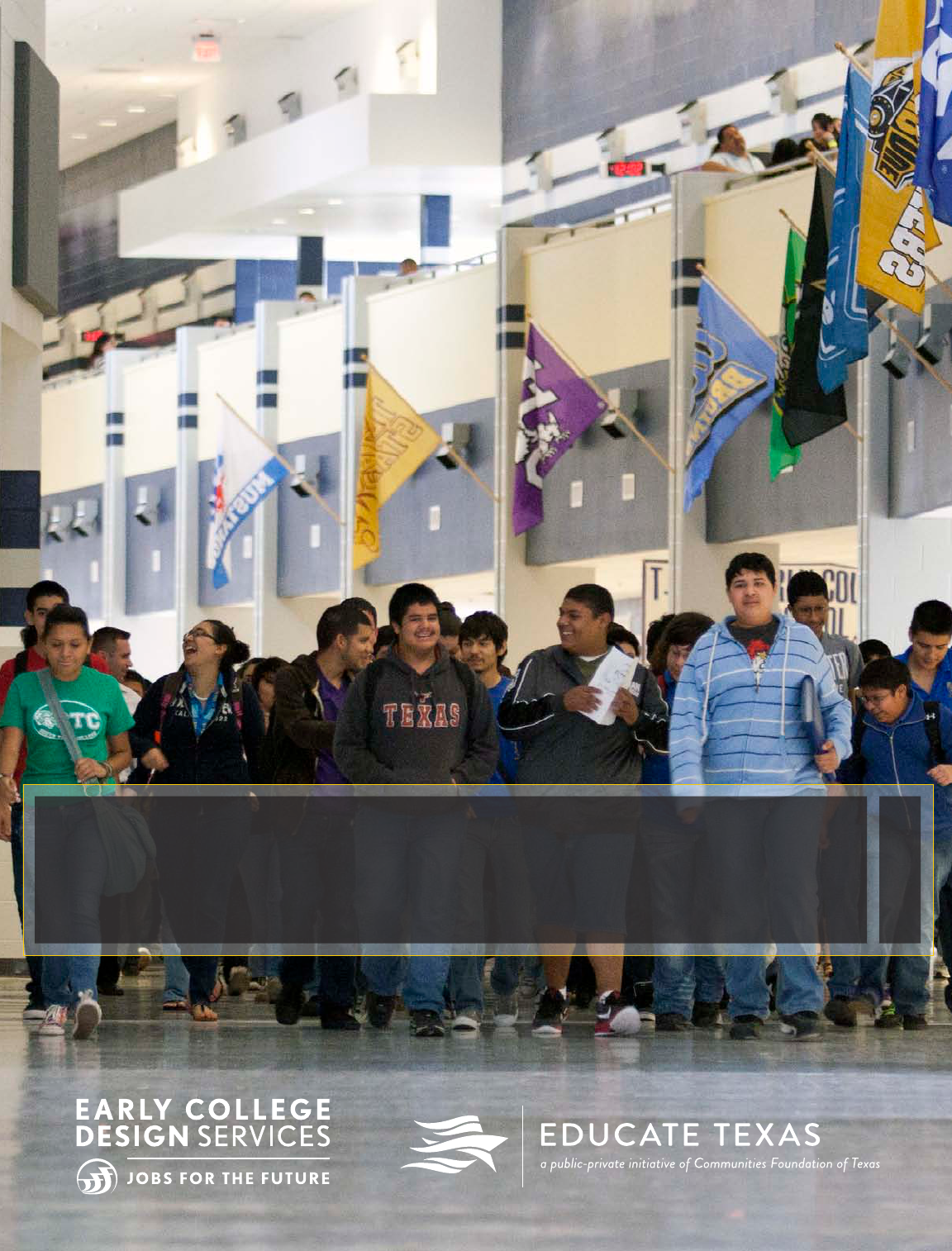
L A U N C H I N G E A R LY C O L L E G E
D I S T R I CT W I D E
P H A R R - S A N J U A N - A L A M O ’ S “ C O L L E G E F O R A L L” S T R A T E G Y
MARCH 2012
By Cecilia Le

Jobs for the Future identifies, develops, and
promotes education and workforce strategies that
expand opportunity for youth and adults who are
struggling to advance in America today. In more than
200 communities across 43 states, JFF improves the
pathways leading from high school to college to family-
sustaining careers.
Through its early college design services for school
districts, JFF helps districts significantly increase the
number of students who graduate from high school and
are prepared to succeed in postsecondary education.
WWW.JFF.ORG
Early College is a bold approach to education reform,
based on the principle that academic rigor, combined
with the opportunity to save time and money, is a
powerful motivator for students to work hard and
meet serious intellectual challenges. Early college
schools blend high school and college in a rigorous yet
supportive program, compressing the time it takes to
complete a high school diploma and up to the first two
years of college. Today, more than 270 early college
schools—including 49 Early College High Schools and 5
blended T-STEM Early College High Schools in Texas—
serve 75,000 students across the nation.
WWW.EARLYCOLLEGES.ORG
Educate Texas (formerly the Texas High School
Project) is a public-private alliance dedicated to
significantly improving the postsecondary readiness
of low-income students, with a focus on students in
low-performing schools. A public-private initiative of
Communities Foundation of Texas, its partners include:
the Texas Education Agency; Office of the Governor;
Texas Legislature; Texas Higher Education Coordinating
Board; Bill & Melinda Gates Foundation; Michael &
Susan Dell Foundation; National Instruments; Greater
Texas Foundation; and The Meadows Foundation.
WWW.EDTX.ORG
Photography: ©2011 Michael Stravato

A B O U T T H E A U T H O R
Cecilia Le develops JFF publications and products
that capture the key elements behind the early
college school designs that connect young people
to postsecondary success. These designs include
early colleges that blend high school and college
coursework in an accelerated program for students
underrepresented in higher education, as well as
Back on Track models that put off-track and out-
of school youth on paths to college and career. She
was the project leader for the Hidalgo Early College
District Toolkit. Recent publications include From
Remediation to Acceleration: Early Lessons from Two
Philadelphia Back on Track Schools; Innovations in
Developmental Math: Community Colleges Enhance
Support for Nontraditional Students; and Accelerating
College Readiness: Lessons from North Carolina’s
Innovator Early Colleges. Prior to coming to JFF, Le
worked at Education Sector in Washington, DC, as a
Thomas B. Fordham Foundation Fellow. She has also
helped prepare Boston students for college through an
intensive tutoring program at MATCH Charter Public
High School. She spent four years as an education
reporter for newspapers in upstate New York and
Wilmington, Delaware.
A B O U T T H I S PA P E R
This paper documents critical design decisions,
operational approaches, and lessons learned from the
first year of the Pharr-San Juan-Alamo Independent
School District’s work to create college-ready,
college-connected pathways for every student under
a $2 million college-readiness grant from the Texas
Education Agency. It also describes the groundwork
and conditions the district put in place in the years
leading up to the grant work. In 2010, through this
grant, Educate Texas engaged Jobs for the Future for a
two-year period to help Pharr-San Juan-Alamo create a
districtwide portfolio of options that enable all students
to graduate high school with at least 12 college credits.
This paper is based on school site visits and interviews
between January and June 2011, as well as on Jobs
for the Future’s experiences supporting the district.
Interview subjects included district administrators,
principals, teachers, counselors, instructional coaches,
students, and individuals from the district’s partner
colleges and organizations.
A C K N O W L E D G M E N T S
I thank the Pharr-San Juan-Alamo Independent School
District for opening its doors for me to document its
innovative work to launch college-going pathways for
all students. I am deeply grateful to Superintendent
Dr. Daniel King, Administrator for College Readiness
Nelda Cantu, Assistant Superintendent for Curriculum
and Instruction Jose Garza, Public Information Officer
Arianna Vazquez-Hernandez, and the many other Pharr-
San Juan-Alamo administrators, principals, teachers,
counselors, staff, students, and instructional coaches
who shared their experiences and insights.
I am indebted to our partners at Educate Texas who
guided and supported this paper: Gene Acuna, Chris
Coxon, Alma Garcia, Paula Garcia, Susan Henderson,
Scott Hollinger, and Heather Zavadsky. I also thank Nick
Gonzalez at South Texas College and Jan Lindsey of
the Texas Education Agency for their valuable insights
about the district’s partnerships.
Finally, I am grateful to my colleagues for their wise
guidance, especially Lili Allen, Lisa Archibald, Frank
De Stefano, Jill Frankfort, Marc S. Miller, LaVonne
Sheffield, Kathleen Smith, and Joel Vargas. Thanks to
Michael Stravato for the photography within, and to
Rochelle Hickey for her elegant design work.


INTRODUCTION 1
LAYING THE VISION, ALIGNING THE PIECES 4
Launching College for All: Starting with Dropouts 4
“We Can’t Do What We Did Yesterday” 5
Building a Portfolio of Early College Designs 6
Developing Rigorous College and Career Pathways 9
At the Middle Level 12
An Expansive View of Counseling 12
Building Districtwide Coherence 13
COLLEGE-GOING RIGOR IN EVERY CLASSROOM 15
A Common Instructional Framework 15
Strong Instructional Leadership 16
Supportive, Continuous Coaching 18
STAYING THE COURSE 20
ENDNOTES 22
TA B L E O F C O N T E N T S

vi
LAUNCHING EARLY COLLEGE DISTRICTWIDE: PHARR-SAN JUAN-ALAMO’S “COLLEGE FOR ALL” STRATEGY

1
EDUCATE TEXAS | EARLY COLLEGE | JOBS FOR THE FUTURE INTRODUCTION
I N T R O D U C T I O N
Across the nation, early college schools are creating a path to college
success for young people underrepresented in higher education. For a
decade, these innovative public schools blending high school and college
have proven that, with the right support, all high school students can
tackle college work. Now, a Texas school district near the Texas-Mexico
border is broadening the early college vision. The Pharr-San Juan-Alamo
Independent School District is challenging and supporting all 32,000
young people in the school system to earn key college credits as they
prepare to graduate from high school. Early college is central to the
district’s commitment that every high school graduate is prepared to
succeed in college.
S
panning three cities, the Pharr-San Juan-Alamo Independent School District is in
some ways unique, yet it also embodies challenges being encountered across the
U.S. educational system. Located about 10 miles from the Rio Grande separating
Texas from Mexico, 99 percent of its students are Hispanic. The region is also one of the
nation’s most impoverished: 88 percent of the families in Pharr, San Juan, and Alamo
are considered economically disadvantaged. Very few adults in the region hold college
degrees, and most of Pharr-San Juan-Alamo’s students will be the first in their families
to attend college. Yet through an innovative and wide-reaching set of strategies, Pharr-
San Juan-Alamo is making college a reality for every young person, from top students to
former dropouts.
Together with its college and community partners, Pharr-San Juan-Alamo is creating
a districtwide portfolio of options that will soon enable all students to graduate from
high school with at least 12 college credits and the skills to progress to a degree or
credential. Some students will graduate with several college courses under their belt,
confident that they can succeed in college. Some will earn industry-recognized technical
certificates that can help them get jobs to work their way through college and advance
their careers. Still others will graduate high school with an Associate’s degree, ready to
specialize in medicine, engineering, or another career path at a four-year college. Across
all these options, their courses of study are being aligned with the skill needs of the local
economy.
How has Pharr-San Juan-Alamo, once troubled by high dropout rates and with barriers to
student success that few schools in the nation have overcome, begun the transformation
toward college success for all? The district’s comprehensive approach to supporting all
students to and through postsecondary education centers on several major strategies:
> College course-taking for all high school students exposes students to the rigor and
expectations of college.
> Career and technical pathways lead to high-growth, high-wage careers aligned to the
local economy’s needs.
2 LAUNCHING EARLY COLLEGE DISTRICTWIDE: PHARR-SAN JUAN-ALAMO’S “COLLEGE FOR ALL” STRATEGY
> District-sponsored counseling located on college campuses supports recent graduates in making the
difficult transition from high school to college.
> Rigorous, college-ready instruction in all middle and high schools, including schools for off-track youth
and dropouts, prepares students to succeed in college coursework.
In 2010, Pharr-San Juan-Alamo adopted the slogan “All PSJA Students: College Ready, College Connected”
to signal its shift toward more rigorous instruction and more relevant dual enrollment pathways for all.
With the start of the school year in 2011, the district expanded that vision to “College
3
: Ready, Connected,
Complete” to signal its commitment to and shared responsibility in helping students not only get to college
but earn a certificate or degree.
A major partner in the work is Educate Texas, a public-private initiative of Communities Foundation of
Texas that works statewide to increase postsecondary readiness for low-income students. Supported by a
major college readiness grant from the Texas Education Agency, Educate Texas is helping the district make
key strategic leadership decisions, brokering partnerships with area colleges and community partners, and
providing instructional coaches to work with teachers at the district’s secondary schools.
Pharr-San Juan-Alamo’s transformation efforts come at a time when the national conversation is sharply
focused on college and career readiness. States around the country are instituting standards for college
and career readiness, which will require districts to increase rigor and align their academic programs.
Ten years after No Child Left Behind, the federal government is grappling with the next generation of
accountability for schools and states. And districts and colleges are under pressure to reduce college
remediation rates and boost completion. This year, Texas put in place a new set of end-of-course tests
linked to graduation that is significantly more rigorous than its previous assessments.
Pharr-San Juan-Alamo is at the beginning of its reform, and its leaders acknowledge many steps are still to
be implemented or improved. But in laying the groundwork for success and launching the reform, outcomes
for students have steadily risen. The district has become a state and national model for dropout recovery,
having graduated nearly 900 former dropouts and off-track students—and connected them to college—
since 2007. All three comprehensive high schools that were formerly labeled “dropout factories” have
raised graduation rates and improved their federal accountability standings. Pharr-San Juan-Alamo has
substantially raised its four-year graduation rates—from 62 percent in 2007 to 87 percent in 2010—and in
June 2011 graduated a record 1,885 students, compared to only 966 in 2007. Additionally, about 1,700 of the
district’s high school students took college courses in the 2010-11 school year, a number projected to rise to
3,500 once every high school fully implements early college pathways. And between 2007 and 2009, the
district doubled its number of students enrolling in college after graduation.
1
Especially significant is the progress that the district has been making in narrowing achievement gaps
for traditionally underserved student groups. Only a third of students from the class of 2007 with limited
English proficiency graduated in four years. By 2010, the four-year graduation rate for limited English
proficiency students was 72 percent, well exceeding state and regional averages. Pharr-San Juan-Alamo
made similar progress with special education students, raising their four-year graduation rate from 54
percent for the class of 2007 to 81 percent for the class of 2010.
This is the story of one district leading the way—a mid-sized, economically disadvantaged school district
determined to offer every student the postsecondary opportunities that begin the pathway to family-
sustaining wages. The first section of this paper describes the groundwork district leaders laid to enable
successful reform and documents how the district created rigorous career pathways and a range of early
college options for all. The second section explores the work Pharr-San Juan-Alamo has undertaken in the
classroom so students have the academic preparation required to meet the challenges of college.

3EDUCATE TEXAS | EARLY COLLEGE | JOBS FOR THE FUTURE INTRODUCTION
P H A R R - S A N J U A N - A L A M O I N D E P E N D E N T S C H O O L D I S T R I C T
Pharr-San Juan-Alamo has 43 schools, including four comprehensive high schools, four alternative
schools, eight middle schools, 26 elementary schools, and one early childhood partnership with the local
Head Start. Of the district’s 32,000 students:
> 99 percent are Hispanic
> 88 percent come from economically disadvantaged families (eligible for free or reduced-price lunch)
> 41 percent are English language learners
Among its achievements, the district has:
> Become a state and national model for dropout recovery, having graduated more than 800 former
dropouts ages 18 to 26 since 2007 and connected them to college
> Raised four-year graduation rates from 62 percent to 87 percent in three years
> Enrolled about 1,700 of its 8,000 high school students in college courses during the 2010-11 school
year—a number expected to rise to 3,500
> Doubled the number of students enrolling in college after graduation between 2007 and 2009
SOURCES: Texas Education Agency Public Education Information Management System; Pharr-San Juan-
Alamo ISD
Pharr-San
Juan-Alamo
Indepen-
dent School
District
4 LAUNCHING EARLY COLLEGE DISTRICTWIDE: PHARR-SAN JUAN-ALAMO’S “COLLEGE FOR ALL” STRATEGY
L AY I N G T H E V I S I O N ,
A L I G N I N G T H E P I E C E S
W
hen Dr. Daniel P. King arrived in Pharr-San Juan-Alamo in 2007, he came
with experience in creating college-connected pathways for every student.
As superintendent in nearby Hidalgo, Texas, a small community a few miles
to the south, he had led the expansion of early college for all to the district’s 3,600
students. Under his leadership, Hidalgo became nationally known for innovation and
results: Along with their high school diplomas, nearly all of the graduates of Hidalgo’s
early college have earned transferrable college credits. Two-thirds of the class of 2010—
the first crop of Hidalgo early college students to graduate—had earned a semester or
more of credit.
King often spoke with other superintendents about Hidalgo’s transformation, but many
were skeptical that its successes could be replicated in large, complex districts. King was
intent on showing that such school systems could achieve college readiness for all. When
he took the helm at Pharr-San Juan-Alamo, he took strategic steps to build the credibility
and support needed for districtwide reform.
L AU N C H I N G CO L L E G E F O R A L L : S TA R T I N G W I T H D R O P O U T S
Pharr-San Juan-Alamo began sowing the seeds for this ambitious work as soon as King
arrived. He immediately launched a novel dropout reengagement strategy that has
doubled the number of annual high school graduates—and that puts former dropouts on
the path to college.
King’s priority was to address an urgent, highly visible problem: the district’s dropout
rate was double the state average. Almost 500 students were being lost each year. “The
number one thing that jumped out and hit me in the face was the dropout situation,”
King said. “The dropout rate was horrendous. That struck me as something to be
addressed immediately.” What’s more, about half of the dropouts had made it all the
way to the senior year but had failed graduation exit exams or not met other graduation
requirements. King felt a moral obligation to find and reengage the 237 seniors who had
not graduated the previous spring.
The key to his response came in partnership with South Texas College and its president,
Dr. Shirley Reed. With South Texas College, Pharr-San Juan-Alamo created the College,
Career, and Technology Academy, a school where former dropouts complete their high
school diploma and seamlessly transition into college courses when they are ready.
Students focus only on what they need for graduation and for college-readiness, and they
begin college courses while finishing their high school requirements. In designing CCTA,
the district took advantage of Texas state policies that encourage districts to recover
dropouts, provide state funding for students who are over compulsory school age, and
promote connections to college for students still in high school.
2
5EDUCATE TEXAS | EARLY COLLEGE | JOBS FOR THE FUTURE LAYING THE VISION, ALIGNING THE PIECES
To recruit dropouts for CCTA’s opening in fall 2007, Pharr-San Juan-Alamo launched an intensive recovery
campaign, anchored by the slogan: “You didn’t graduate from high school? Start college today!” Mayors,
school leaders and staff, and other community leaders knocked on the doors of students who had not
returned to school that fall. Young people who did not respond to one visit got two; King also personally
visited homes. In CCTA’s first month, the district enrolled 223 of those 237 dropouts. Within a year, 210
students had graduated. To date, the school has graduated nearly 900 former dropouts and worked to
connect them to college.
The district has followed this intensive recruiting strategy every year since, and has expanded its strategy
to capture off-track students before they ever officially drop out. Students who are close to graduation
but lack enough credits are given the chance to go to CCTA the summer or fall immediately following what
should have been their four-year graduation date. And beyond CCTA, the district’s comprehensive dropout
prevention efforts include transition communities at each high school, composed of teams of teachers who
give intensive academic support, make home visits, and employ other prevention strategies with students
who have failed courses or are otherwise at risk of not succeeding academically.
CCTA has become a national model for dropout recovery. In 2011, the Texas legislature enacted a bill,
authored by State Senator Juan “Chuy” Hinojosa, to encourage replication of the district’s dropout
recovery program across the state. Jobs for the Future, a national organization helping the district
implement college pathways for all, has featured Pharr-San Juan-Alamo’s innovative use of state policy
to create this effective school. (CCTA now serves as the anchor site for Jobs for the Future’s regional
work to develop Back on Track schools that put former dropouts and other off-track youth on a path to
postsecondary success.)
King paved the way for districtwide reform by addressing a clear crisis first: the high number of
dropouts. His strategy—putting a priority on the college-going agenda by focusing first on dropouts—
was counterintuitive, but it was effective. By reengaging large numbers of dropouts who were close to
graduation, the district achieved a quick, substantial win that allowed it to begin to make the case for
college for all.
“The groundwork was being laid as we were connecting the dropouts to college,” King said. “Here’s Julio,
who we got at 26 years old and he dropped out eight or nine years earlier. Now he’s got his high school
diploma, he earned his Associate’s degree, and he’s working on his Bachelor’s degree. If we can do that
with that kind of student, why shouldn’t all of our A and B and C students who are at least progressing and
earning their credits and they’re hanging in there—why can’t any one of them do what Julio is doing?”
“ W E C A N’ T D O W H AT W E D I D Y E S T E R D AY ”
The success of the College, Career, and Technology Academy brought King the credibility to expand college-
readiness efforts. At the same time, he tackled another pressing issue—building much-needed morale among
teachers—by listening to and addressing their concerns.
Before King had arrived in Pharr-San Juan-Alamo, the district had begun to create small learning
communities at each high school as part of a districtwide effort to personalize education and learning.
Still, many details needed to be ironed out, such as scheduling problems that resulted from the reform.
Throughout 2007, King spent time at each high school, inviting every teacher to share concerns and
frustrations. He analyzed teachers’ concerns, returning to each school within a month of visiting it. And
when he did so, he came with solutions and options to make the reform initiative run smoothly, such as
offering to engage consultants to rework master schedules. King then established a superintendent’s
advisory council of teachers to return ownership of the reform to the school community—a council that later
helped inform King and the district’s development of college-ready pathways.

6 LAUNCHING EARLY COLLEGE DISTRICTWIDE: PHARR-SAN JUAN-ALAMO’S “COLLEGE FOR ALL” STRATEGY
“If we give up on this reform, they’re never going to want to do another reform,” he explained. “My message
to them was, ‘We’ve got 500 dropouts a year, we’ve got all three high schools in serious AYP [Adequate
Yearly Progress] trouble. We can’t do what we did yesterday.’”
Teachers and administrators across the district speak of the appetite for improvement that King’s
leadership has brought to Pharr-San Juan-Alamo. “It has to start at the top, or else it doesn’t work at all,”
said high school science teacher Hector Sandoval, who has taught in the district for 30 years. “He is a good
motivator. . . . He does think out of the box, but when we use that term, we literally mean things we’ve never
done before. We finally had a leader who knew what he wanted to do and said, ‘This is the message and this
is what we are going to do whether you like me or not.’ And most of us said, ‘Yes, we do like you, so yes,
we’ll follow.’”
B U I L D I N G A P O R T F O L I O O F E A R LY C O L L E G E D E S I G N S
King and his team were focused on increasing dual enrollment opportunities so that all students could be
exposed to college experiences while still in high school. In April 2008, Educate Texas and South Texas
College approached King about opening an early college in Pharr-San Juan-Alamo. As in Hidalgo, he was
attracted to the early college concept because it could bring a unifying vision and structure to the many
college and career readiness efforts already underway at the district. The more challenging question was
how to leverage the early college concept to achieve systemic transformation.
Most early colleges have 400 or fewer students, a design that reaps the benefits of small schools. In
Hidalgo, King had gained approval to expand early college to all 800 high school students, but creating
early colleges all at once for the 8,000 high schoolers in Pharr-San Juan-Alamo seemed less feasible. Still,
King did not want to limit early college opportunity to 400 high school students.
“In my way of thinking, if you don’t get systemic transformation, you really haven’t done anything,” he
said. “Pilots are nice, magnet schools are nice, all these things are nice, but if you don’t get systemic
transformation, you really haven’t solved the issues that we have in education.”

7EDUCATE TEXAS | EARLY COLLEGE | JOBS FOR THE FUTURE LAYING THE VISION, ALIGNING THE PIECES
One of five blended T-STEM early college high schools in Texas, the school was designed to increase the
number of students entering science, technology, engineering and mathematics fields—so they are prepared
for good jobs in the region, many of which require significant STEM preparation. Staff hired at the new
early college worked closely with South Texas College, meeting weekly with department chairs to align
curricula and articulate sequences of early college courses leading toward Associate’s degrees in STEM
fields. All students enroll in college classes by sophomore year, and they receive intensive support from
their early college teachers to ensure they succeed in those classes. Through a summer bridge program and
throughout the school year, students prepare for college placement tests and learn college skills. Through
this blended model of high school and college, students make a seamless transition between the two
systems and graduate with the knowledge and confidence to succeed in further postsecondary study.
PSJA Thomas Jefferson T-STEM has become a model for preparing students to excel in rigorous high school
and college courses. From there, King and the district began thinking about how to use the early college
model to transform the whole district. One lesson that King learned in Hidalgo was that one path does not
fit all. In Hidalgo, University of Texas-Pan American initially served as the primary postsecondary partner
for early college, but as the district quickly found, to offer students a range of rigorous courses, career-
focused and otherwise, it also needed to partner with technical and community colleges.
The solution: the district would create one early college and use it as an incubator for the idea of
connecting all students to college. The PSJA Thomas Jefferson T-STEM Early College High School opened in
fall 2008 with 115 ninth graders; 100 of which would be the first in their family to go to college.
A N AT I O N A L L E A D E R I N E A R LY C O L L E G E
Texas is a pioneer in opening early college schools and expanding college-going opportunities to low-
income students. With the Texas Education Agency, Educate Texas, Jobs for the Future, and college
partners, school districts in Texas have opened 49 early colleges and 5 T-STEM early colleges since 2004.
Early college students in Texas:
> Are 66 percent Hispanic, 63 percent low-income, and 74 percent rst-generation college goers.
> Have accumulated an average of 24 college credits, which represents more than a semester of full-
time credit.
> Are twice as likely to pass state exams in all four subject areas as peers in comparison schools, and
are more than twice as likely to pass Algebra II or geometry by the end of the tenth grade, according
to a 2010 quasi-experimental study by SRI International.
Texas state policies that support early college and dual enrollment for all include:
> Since 2003, districts can claim ADA funding for dual enrollment students. Schools that deliver
college courses through high school faculty designated as adjunct faculty by the college can use ADA
to pay for this college-level coursework.
> Colleges may partially or fully waive tuition for dual enrollment students.
> HB 1, a comprehensive effort to improve college readiness in Texas, authorized a $275 per-student
allotment that districts may use to promote dual enrollment and other college success strategies in
high school.

8 LAUNCHING EARLY COLLEGE DISTRICTWIDE: PHARR-SAN JUAN-ALAMO’S “COLLEGE FOR ALL” STRATEGY
A range of pathways was just as crucial in Pharr-San Juan-Alamo, a school district 10 times Hidalgo’s
size. To provide college-going options for every student, whatever their skills and aspirations, the district
needed a diverse portfolio of school designs and college options. Some students would earn 60 credits by
graduation, others 12, and others perhaps just a few. King was especially sensitive to the needs of students
with learning disabilities and students who start high school far from college-ready.
“We’re talking about connecting all of them to a useful future,” he said.
We can teach them what they can do and what they can become, and the fact that they
start [at community college] doesn’t mean that they can’t get their Ph.D. someday if
that’s what they want to do. So I think we learned that when you really commit to all
students, you’ve really got to look at how you are going to support [early college for all]
with all different kinds of students. I think that transferred very well [from Hidalgo].
In May 2010, the district received a $2 million college-readiness grant from the Texas Education Agency
to make King’s vision of college readiness for all a reality. In 2010, the district opened a provisionally
designated early college within PSJA North High School, designed to act as a lever to drive change
throughout the comprehensive high school.
3
Teachers from PSJA North Early College work closely with
their colleagues throughout North High School to share practices.
Based on its experience with PSJA Thomas Jefferson T-STEM Early College and PSJA North Early
College, the district applied to the Texas Education Agency in 2011 to open an early college on each of
its comprehensive high school campuses. In the fall, PSJA Southwest High School, then only one year
old, reopened as PSJA Southwest Early College High School—taking the concept of early college from
the exception to the norm. PSJA Southwest had opened the previous year to accommodate the district’s
growing enrollment, serving students from some of the poorest sections of the district. The school, which
opened with 350 ninth graders, eventually will serve 1,800 students. Unlike the district’s first two early
colleges, each a small school of choice designed for about 400 students, PSJA Southwest is a large,
comprehensive, provisionally designated early college serving all students living within its boundaries.
P H A R R - S A N J U A N - A L A M O H I G H S C H O O L S
The Pharr-San Juan-Alamo Independent School District has four comprehensive high schools, all with
early college pathways that offer students the opportunity to earn college credits while in high school.
> In 2010, PSJA North High School opened a small early college high school within its building that will
eventually serve about 400 students.
> PSJA Southwest Early College High School, which opened in 2010, is a comprehensive early college
high school that will eventually serve about 1,800 students.
> PSJA High School and PSJA Memorial High School, each large, comprehensive high schools, are
going through a planning year to prepare to apply for state designation to open early colleges within
their schools in fall 2012.
In addition, the PSJA Thomas Jefferson T-STEM Early College High School opened in 2008, serves 400
students, and is developing into a demonstration site to spread effective instructional practices across and
beyond the district.
The district also has four alternative high schools focused on connecting students to college before
graduation.
9EDUCATE TEXAS | EARLY COLLEGE | JOBS FOR THE FUTURE LAYING THE VISION, ALIGNING THE PIECES
Now in its fourth year, PSJA Thomas Jefferson T-STEM Early College serves as a learning lab that displays
college-ready instructional practices and culture. Structured, cross-school visits spread effective practices
to educators across and beyond the district.
“We’re working on being a strong learning community, and it’s trickling out to our entire district,” said Ana
Gonzalez, the school’s founding principal, now overseeing instructional reform as the district’s director of
the Common Instructional Framework. “What we’re doing is really transformational.”
D E V E LO P I N G R I G O R O U S C O L L E G E A N D C A R E E R PAT H WAY S
Across its new portfolio of schools based on early college designs, the district needed to align its career
and technology course offerings with the mission of college readiness for all. It was not clear that the
schools’ career and technology programs were leading to postsecondary education or high-wage careers
in the Rio Grande Valley. Working with Jobs for the Future, Pharr-San Juan-Alamo conducted an audit
of its career and technology course offerings as a step toward aligning them with current and projected
opportunities in the local labor market.
This work involved compiling publicly available labor market data and gathering information from local
employers about the entry-level jobs and advancement prospects in their industries. At the same time, Jobs
for the Future worked with the district to review its course documents, class registration files, textbooks,
and other materials, as well as to conduct classroom interviews. Through this process, the district gained
the information it needed to move away from obsolete programs, while expanding or creating programs that
put students on trajectories to college and career success. For example, knowing health care is a prominent
and quickly growing industry in the region, the district identified specific courses and career pathways—
such as pharmacy technician, certified medical assistant, health informatics, and emergency medical
technician—that would lead toward high-paying, high-growth health care positions. District staff also relied
on the earlier experiences of its Thomas Jefferson T-STEM Early College, which had done significant work
with South Texas College to develop a range of degree plans for early college students to work toward
Associate’s degrees in their areas of interest.
Pharr-San Juan-Alamo and JFF recommended a plan to offer six broad career clusters; each contained two
or three specific career pathways, giving the schools flexibility to choose which to implement. From there,
district staff working with JFF developed a plan to place every student on a pathway to earning 12 or more
college credits by graduation:
> All ninth graders take a college-readiness course that explores the available career clusters, emphasizes
technical reading, writing, presenting, and project work, and teaches specific college-ready behaviors,
such as taking notes and managing time.
> With help from a counselor, students choose a career cluster by the end of the ninth grade.
> Each tenth grader takes a course introducing the principles of her or his chosen career cluster, providing
the foundation to choose a more specialized career pathway in that cluster as upperclassmen.
> The district’s goal is to support all juniors and seniors to pass introductory English and math at the
college level, getting them ready to enter college with no need for remediation.
> Through the district’s partner colleges, juniors and seniors will pursue six or more transferrable college
credits in their career pathways.
Over the next two years, the district will finish putting its early college pathways in place, while phasing out
programs and courses that do not lead to postsecondary education. The district is creating online maps of

10 LAUNCHING EARLY COLLEGE DISTRICTWIDE: PHARR-SAN JUAN-ALAMO’S “COLLEGE FOR ALL” STRATEGY
the career pathways so students and families can see how the college courses they take in high school lead
to concrete certificate and degree programs. In addition, all career and technology teachers are receiving
professional development in college-ready instructional strategies.
“We need to offer these kids that opportunity [for career-focused college coursework] so when they
graduate, they already have an impetus or a catalyst—they already have hours and they’ll continue,” said
Nick Gonzalez, South Texas College’s associate dean of high school programs and services, who has worked
closely with the district as it expands its dual enrollment offerings. “Whether for a doctorate degree or for
a Bachelor’s or for a career and technology course of their choosing, they need to think they’re going to go
to college so that high school becomes like a platform, like a conveyor belt to go on to college rather than a
staging area.”
This is a sample of the sequence of career and technical courses a student in the health sciences cluster/
pharmacy technician career pathway might take in addition to core academic courses. Courses for college
credit have an (*). By graduation, the student will be on his or her way to a pharmacy tech certication and
have a solid foundation to pursue additional higher education in health sciences.
9TH GRADE
Principles of Information Technology
10TH GRADE
Principles of Health Science
Professional Communications
11TH GRADE
Health Science
Medical Terminology
*
Lifetime Wellness and Nutrition
12TH GRADE
Anatomy and Physiology
*
Health Science Practicum, Pharmacy Tech
*

11EDUCATE TEXAS | EARLY COLLEGE | JOBS FOR THE FUTURE LAYING THE VISION, ALIGNING THE PIECES
B R I N G I N G K E Y PA R T N E R S TO G E T H E R
To support college-going opportunities for all, districts need a network of local, regional, and state relationships.
Partners strategically provide support, expertise, and external pressure, even as the district develops its capacity
to sustain reform. Pharr-San Juan-Alamo’s range of partners includes colleges, state and local agencies, public
ofcials, local business partners, foundations, educational councils and networks, and local charter schools.
Working with the district to coordinate all the partners is Educate Texas, a public-private initiative of
Communities Foundation of Texas to advance college readiness across the state. “I think one key thing I would
put to anybody starting to do something like this is have outside partners [like Educate Texas],” Superintendent
King said. “Not even so much for money or anything like that, but having outside people challenge you: ‘Tell me
what that would look like. Tell me what that means.’ I think brings a lot of discipline and rigor and urgency to
what you’re doing.”
The Texas Education Agency, which gave the district a $2 million college-readiness grant in 2010, has been
closely involved in supporting and monitoring the scale-up of Pharr-San Juan-Alamo’s college pathways. The
district is taking part in a major pilot project with the Texas Education Agency and the Michael & Susan Dell
Foundation to build a next-generation data system that makes real-time data available to inform district and
classroom decision making and empowers parents and students to track their own academic progress. The
Region One Education Service Center has provided technical assistance to the district and supported its data
collection. And with the local charter school network IDEA Public Schools, the district has a $5 million federal
Investing in Innovation grant to work with Teach for America on strengthening the pipeline of highly effective
teachers and leaders that can serve the region’s high-need students.
To be able to offer college courses to all high school students, the district has built robust partnerships with
local colleges, as well as with the Texas Higher Education Coordinating Board. In Pharr-San Juan-Alamo,
students take college classes through South Texas College, University of Texas-Pan American, and other college
partners. Through Educate Texas, presidents from ve Rio Grande Valley colleges—South Texas College, Texas
State Technical College, UT-Pan American, UT-Brownsville, and Texas Southmost College—recently came
together to discuss expansion of dual enrollment opportunities for students in the Rio Grande Valley.
Jobs for the Future, a national organization working with Educate Texas, delivers intensive professional
development to Pharr-San Juan-Alamo to support college-ready instruction across the middle and high schools.
JFF also advises on the development of early college pathways in every school, works continuously with the
central ofce to build district capacity to support its mission, documents promising practices and lessons
learned, and leads policy and advocacy work to support early college.
Spreading the word about a college-for-all expectation has been critical to gaining the buy-in of the community.
Elected ofcials, such as Congressman Ruben Hinojosa and the cities’ mayors and commissioners, have
bolstered the district’s efforts by regularly talking to constituents about the importance of college readiness.
King, who is the current president of the South Texas Association of Schools and serves on the State P-16
Council, also shares this message and the lessons emerging from the work at Pharr-San Juan-Alamo to district
leaders in these networks. “You’ve got to sell one message,” said Alma Garcia, Educate Texas’s program ofcer
for early college. “You can’t go all over the place.”
To spread this work beyond Pharr-San Juan-Alamo, Educate Texas is leading a wide-reaching effort to take
early college for all to regional spread and scale in the Rio Grande Valley. This includes spreading the vision and
lessons learned, coaching other superintendents, advising on the design of college-connected school models,
working with area colleges to increase their capacity for dual enrollment, and more.
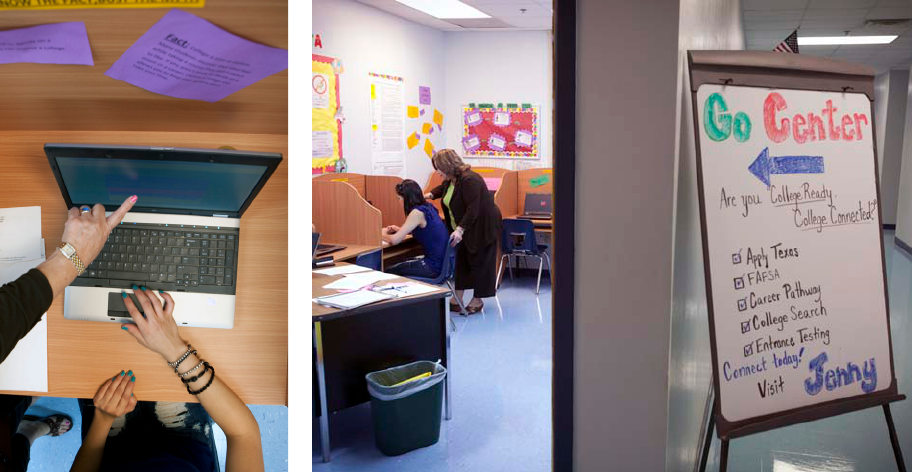
12 LAUNCHING EARLY COLLEGE DISTRICTWIDE: PHARR-SAN JUAN-ALAMO’S “COLLEGE FOR ALL” STRATEGY
AT T H E M I D D L E S C H O O L L E V E L
For students to graduate from high school prepared to succeed in college, districts need to align their
curricula and instruction—from college down through high school, middle school, and even elementary
school. Pharr-San Juan-Alamo has begun making progress at the middle school level.
With its college-readiness grant, Pharr-San Juan-Alamo instituted college-ready instructional coaching in all
middle schools, not just high schools. In 2011, a new Texas Title I Priority Schools grant enabled the district
to significantly intensify the dosage of coaching at four middle schools. The middle schools are putting
more rigorous pre-Advanced Placement courses in place so that students are prepared for AP and college
courses in high school. And students begin exploring colleges and career paths at the middle schools, which
build a college-going culture in a variety of ways.
At Escalante Middle School, which feeds into the new PSJA Southwest Early College High School, 98
percent of students are low-income. The two schools share a building, and their leaders formed a plan to
work together to align their curricula. Escalante students research the costs and admissions requirements
of colleges locally and across the nation, and they explore online the courses of study offered. Escalante
also gives every student an introduction to—and preparation for—college placement tests such as the SAT
and ACT, and the school plans to take all eighth graders on a college visit this year. At Kennedy Middle
School, which also feeds into Southwest, Principal Norma Garza makes a point of mentioning college each
morning in her school-wide announcements.
“It’s something very exciting for our parents and our families that we’re getting out that communication to
them,” said former Escalante Principal Iris Guajardo, now the district’s Title I director. “It has been a big eye
opener. Parents are saying, ‘My kids are starting to do this as early as this grade level, and they’re going to
go to college.’”
A N E X PA N S I V E V I E W O F C O U N S E L I N G
The district has taken strides to revamp and align its college and career counseling, another activity that
had been primarily governed at the school level. In the past, students who attended different high schools
may have received different information; students who moved from one high school to another could miss
13EDUCATE TEXAS | EARLY COLLEGE | JOBS FOR THE FUTURE LAYING THE VISION, ALIGNING THE PIECES
steps in the college preparation process. Counselors from the district’s secondary schools worked together
during 2011 to create standardized counseling documents that give students clear, timely information about
college and career options, as well as a standard schedule of college-focused events such as fairs and
financial aid sessions.
“The financial aid advisors, the counseling department, and the career and technology department were
basically programs that were on their own,” said Nelda Cantu, the district’s administrator for college
readiness. “So what I’ve done is, for example, I brought in the financial-aid advisors, the middle school
counselors, and the high school counselors to work together. I’m trying to align all three programs so that
they can support each other, and they can work together and communicate.”
An innovation of particular note is that Pharr-San Juan-Alamo’s counseling program does not end when its
graduates go to college. The district wants to see its graduates earn a college degree or other credential.
With its college-readiness grant, Pharr-San Juan-Alamo hired three college transition counselors to support
the college persistence of graduates, particularly through the first year. At South Texas College and UT-Pan
American, each school has a dedicated office where a counselor can give Pharr-San Juan-Alamo students
advice on course options, assistance with financial aid, and answers to other questions. The third counselor
helps graduates of the district’s alternative campuses make a smooth transition into college and overcome
life challenges, such as child care needs and work responsibilities.
These transitional counselors work to create a seamless support system from the high school counseling
program to the college advisory program. They begin coordinating their work with the high school
counselors during students’ senior year of high school, then take the lead over the summer to get students
enrolled and “in the seat” at college. The transitional counselors gradually phase into a support role as
college advisory services take over and act as a resource to students until they have successfully begun
their second year of college. For graduates of the district’s alternative campuses, who are more highly at
risk, Pharr-San Juan-Alamo plans to provide support until they earn a degree or certificate. The district and
the two partner colleges, after a months-long process, reached agreements to provide the counselors with
access to student data so they can better track and support their progress.
Because so many of the district’s college students are first-generation college goers, the counselors play
a crucial role in this first year of college in helping students develop “college knowledge,” such as how
to read their course schedules and which campus offices to submit paperwork to. As a new semester
began in January 2011, counselors called each student who had graduated in 2010 to learn whether
they were enrolled in college and if they were facing any barriers to college, such as tight finances,
poor transportation, or failing grades. Because young people often move and change phone numbers,
the counselors make special efforts to maintain contact, linking to students on social networks such as
Facebook and keeping in touch through younger siblings still enrolled in the district.
“In the past, once they graduated, that was it. There were no supports,” said Rosie Robles, the district’s
college transition specialist based at South Texas College. “Now for the first time, this resource is available
to them. We are here solely to serve students from the district. We’re making them feel like it’s possible
and there’s someone to hold their hand along the way. We’ve gotten to know them, started to form these
relationships with them so that next time they need help, they will come back.”
B U I L D I N G D I S T R I C T W I D E CO H E R E N C E
In any reform, the district’s central office must be able to signal, support, and sustain change, and to ensure
it spreads to every school and classroom. To carry out reform effectively, Pharr-San Juan-Alamo is moving
from a decentralized school district to a unified system aligned with the priorities of college readiness. The
central office and the district have restructured in a variety of ways.

14 LAUNCHING EARLY COLLEGE DISTRICTWIDE: PHARR-SAN JUAN-ALAMO’S “COLLEGE FOR ALL” STRATEGY
One key action by King was to create an Office of College Readiness, funded by the college-readiness grant
from the state. The administrator for college readiness reports directly to the superintendent, a structure
that helps ensure that college-readiness initiatives have a high priority and can get done quickly. The
district placed the Career and Technical Education and counseling departments under the Office of College
Readiness to ensure that all roads lead to college.
In the past, most decisions about course offerings, professional development, curricula, counseling,
and other matters were made at the school level. Now, to support the common mission, the district is
standardizing many operations to focus curricula and instruction and build toward college readiness. For
example, to ensure Pharr-San Juan-Alamo aligns its instructional resources toward college readiness, the
district engaged Jobs for the Future to conduct an audit of the district’s professional development. Through
this audit, JFF helped the district pinpoint where it was spending time and resources on non-priority areas.
With this knowledge, the district can focus on professional development activities that align directly with
college-ready instruction.
Pharr-San Juan-Alamo is also in the process of aligning curricula across the district in support of college
readiness. Although the whole district uses the CSCOPE curriculum system, different schools have used
different aspects of it and in different ways. The district learned that nearby Brownsville Independent
School District had identified specific aspects of CSCOPE to use districtwide as a systematic effort to
increase curricular rigor. So in spring 2011, Educate Texas facilitated a visit to Brownsville for a team of
about 15 Pharr-San Juan-Alamo administrators to learn how Brownsville accomplished curriculum alignment
and to apply those lessons in Pharr-San Juan-Alamo.
“We don’t say, ‘This kid isn’t going to college so we only prepare him to this skill level,’” said Jose Garza,
the district’s assistant superintendent for curriculum and instruction. “Our message, in everything we do, is
that every kid will leave high school with the skill to go into college with.”
F I N A N C I N G CO L L E G E F O R A L L
To fund college for all, Pharr-San Juan-Alamo has used a mixed strategy of raising money to support
its mission, capitalizing on state policies, and creating innovative cost efciencies. A $2 million college-
readiness grant from the Texas Education Agency pays for key college readiness activities such as
professional development for teachers and leaders and the development of college pathways. Beyond that,
the district has taken advantage of additional grant opportunities to support its mission.
Texas allows Pharr-San Juan-Alamo and other districts to enroll students in college courses tuition-free
through early college and dual enrollment options. Other key considerations in nancing college-going
opportunities for all include the cost of transporting students to the college campus and paying professors
to teach courses at the high school.
To make the costs of a college for all strategy sustainable, Pharr-San Juan-Alamo offers salary incentives
for teachers to earn Master’s degrees and become adjunct instructors through one of the local colleges.
That way, they can teach college courses on the high school campus, increasing the district’s capacity to
deliver college courses and reducing the costs of transporting students to the college campus.
In addition, the district and its partner, South Texas College, have agreed on creative space-sharing
arrangements that save money. For example, the college has plans to use the district’s new T-STEM Early
College building at night to hold classes for its growing student body.
“There will be people that will say, ‘Well, I don’t have a grant. I can’t do this,’” King said. “What I will tell
you is we were going to do this with or without the grant. What I tell people when we talk about grants
is the grant will help us get further faster, but the grant is not what’s going to make a difference between
whether we’re going to do this or not.”
15EDUCATE TEXAS | EARLY COLLEGE | JOBS FOR THE FUTURE LAYING THE VISION, ALIGNING THE PIECES
C O L L E G E - G O I N G R I G O R I N
E V E R Y C L A S S R O O M
F
or structural reform to succeed, the district knew it also needed to accelerate
instructional reform. Putting students in college courses would not benefit them
without the solid academic preparation needed to succeed in those courses.
While pushing reform forward at the district and school levels, Pharr-San Juan-Alamo
recognized that the foundation for change must be in the classroom.
With research indicating that teacher quality matters most for student achievement,
policymakers across the nation are focusing on teacher effectiveness. While many
districts and states are experimenting with systems that reward the best teachers
while weeding out ineffective ones, Pharr-San Juan-Alamo emphasizes the need to
concentrate on improving the effectiveness of the entire teaching force. To accelerate
student learning so every student can tackle college courses in high school, Pharr-San
Juan-Alamo’s strategy is to ramp up the teaching force it has, empowering teachers with
college-ready instructional strategies that, with practice, any teacher can use.
A C O M M O N I N S T R U C T I O N A L F R A M E W O R K
To support the success of college for all, every one of the district’s secondary schools
has adopted Jobs for the Future’s Common Instructional Framework, which prepares
all students, regardless of incoming skill level, for college-level work. The instructional
strategies that make up this framework foster high-level intellectual discussion and
inquiry, make challenging material engaging and accessible, and encourage students
to take ownership of the learning process. Through consistent exposure to these
instructional strategies, students develop the key knowledge, skills, and habits of mind
shown to lead to success in college. Particularly important in Pharr-San Juan-Alamo,
where 41 percent of students are English language learners, the Common Instructional
Framework gives students with limited English proficiency constant opportunities to
practice academic conversation and writing. In this way, the strategies support the
district’s dual language program and its goal of graduating college-ready students bi-
literate in English and Spanish.
These strategies, used in early colleges and other schools across the nation, are deeply
rooted in pedagogical research and have a strong record of success in practice. The JFF
Common Instructional Framework was developed at University Park Campus School,
a nationally recognized, nonselective public school serving one of the lowest-income
neighborhoods in Worcester, Massachusetts. Despite students’ low entering skill levels,
every student has graduated from the high school in five years or less, and 85 percent
of graduates since the school’s founding in 1997 are enrolled in college or have earned
a postsecondary credential. JFF brings teachers and school leaders from around the
country to University Park for a multi-day residency that demonstrates the strategies in
action and shows why and how to implement the framework across grades and content

16 LAUNCHING EARLY COLLEGE DISTRICTWIDE: PHARR-SAN JUAN-ALAMO’S “COLLEGE FOR ALL” STRATEGY
areas. After the residency, instructional coaches working with the district offer intensive, ongoing support
to help teachers implement the strategies in their own classrooms.
“Even though [University Park] was a small school, I could relate to it,” said Nora Rivas-Garza, the principal
at PSJA Southwest Early College, who visited the school in fall 2010 as part of a team from Pharr-San Juan-
Alamo. “The teachers had a very good attitude of what needed to happen in the classroom with the kids. It
was good instruction. When I came back, I told the teachers, ‘You know what? This is exactly what we need—
we have the same thing here. The kids look the same.’”
To adopt the Common Instructional Framework system-wide, Pharr-San Juan-Alamo relied on instructional
coaching and comprehensive professional development from Educate Texas and Jobs for the Future. For all
middle and high school teachers across the district to buy into the college-ready instructional strategies
and use them consistently requires strong, continuous instructional leadership and focused work, supported
by continuous coaching and professional development.
S T R O N G I N S T R U C T I O N A L L E A D E R S H I P
Pharr-San Juan-Alamo principals lead instructional redesign. They make the case for change, structure
school schedules to enable common planning time, and act as strong, highly visible instructional leaders
who model the use of college-ready teaching strategies.
At PSJA North High School, former Principal Narciso Garcia—now expanding early college as superintendent
of neighboring district La Villa—used student data to convince teachers they needed to change their
classroom practice. As teachers recall, Garcia called them all together at the beginning of the year and
J F F CO M M O N I N S T R U C T I O N A L F R A M E W O R K
The JFF Common Instructional Framework is a set of six research-based instructional strategies that
prepares all students, regardless of incoming skill level, for college-level work.
Collaborative Group Work brings students together in small groups to engage in learning, with each
student accountable for her or his contribution. Activities are designed so that students with diverse skill
levels are both supported and challenged by their peers.
Writing to Learn helps students, including English language learners, develop their ideas, critical
thinking, and uency of expression in all subjects. Students experiment with written language in every
class every day.
Literacy Groups, a form of Collaborative Group Work, provide students a supportive structure for
accessing challenging texts, broadly dened, and engaging in high-level discourse. Using roles that have
an explicit purpose, students deconstruct text and scaffold one another’s learning.
Questioning challenges students and teachers to use deep, probing questions to foster purposeful
conversations and stimulate intellectual inquiry.
Classroom Talk encourages all students to develop their thinking, listening, and speaking skills and
promotes active learning. Classroom Talk takes place in pairs, in groups, and with whole classes.
Scaffolding encompasses a broad range of techniques (such as pre-reading activities and graphic
organizers) that help students connect prior knowledge—from an earlier grade, different content area, or
personal experience—to challenging new concepts.
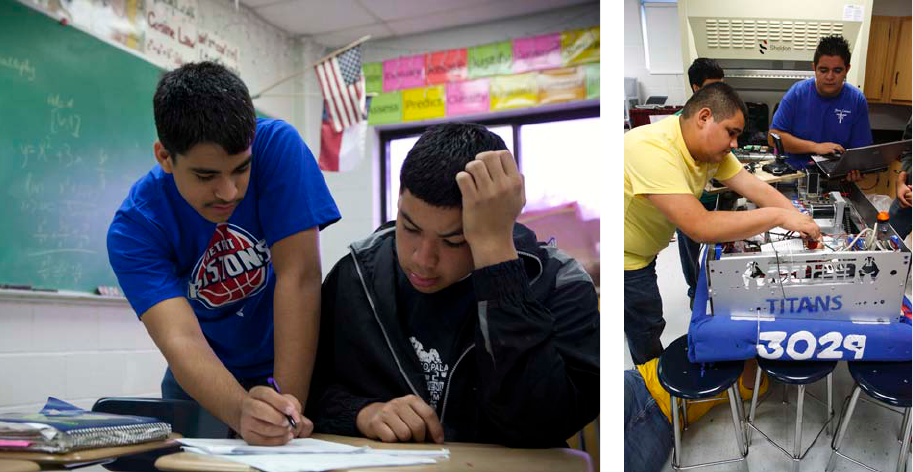
17EDUCATE TEXAS | EARLY COLLEGE | JOBS FOR THE FUTURE COLLEGE-GOING RIGOR IN EVERY CLASSROOM
showed each their students’ benchmark test data. Failure rates were unacceptably high. “He showed us
our data, then he said, ‘Let’s try something else.’ And that’s when he introduced the Common Instructional
Framework,” recalled science teacher Hector Sandoval. “You have to be able to communicate with your kids.
Standing there for an hour and lecturing, you did your job, but if they didn’t get the connection, then it was
a wasted hour.”
At Escalante Middle, nearly six in ten students are in programs that support English language learners, and
many others have only recently exited the program. During the summer before Escalante opened, teachers
had strongly voiced the need to incorporate vocabulary and language development across all content areas.
In August, as the district adopted the Common Instructional Framework, JFF held professional development
sessions to introduce it to groups of teachers. One of these sessions targeted Southwest and Escalante.
“We brought in all of our teachers, and when they began to see the similarities of language development in
the Common Instructional Framework, they bought in,” said former Escalante principal Iris Guajardo. “They
said, ‘Yes, this is what we need. We need to get students talking.’”
Leaders at several district schools speak of modeling the Common Instructional Framework by using the
strategies in faculty meetings. Because student-centered lessons require careful planning, school leaders
structure their schedules to create common planning time within each department. Principals say they have
stepped outside their managerial positions to take a more hands-on role as instructional leaders, observing
each classroom several times a week. And the district has standardized its classroom walk-through tools
so that across every school, leaders are looking for the same college-readiness strategies in action. These
observations are not for evaluation purposes, school leaders emphasize, but to gain a better understanding
of college-ready instruction, encourage a culture of peer learning, and coach teachers to implement the
strategies in a coherent way across all classrooms.
“I hear everybody—from state senators to the president to our superintendent—talking about college ready,”
said Rivas-Garza, the leader at Southwest. “But if we’re not willing to change the way our classrooms look,
then we’re lying to the kids, we’re lying to the parents, we’re lying to everybody. So I told the teachers,
‘We can receive all this training, but if you close the door and you do the same thing, then we’re wasting
our time.’”
18 LAUNCHING EARLY COLLEGE DISTRICTWIDE: PHARR-SAN JUAN-ALAMO’S “COLLEGE FOR ALL” STRATEGY
S U P P O R T I V E, CO N T I N U O U S CO AC H I N G
With the college-readiness grant from the Texas Education Agency, the district initially planned to pilot
college-ready instruction with a small group of teachers, administrators, and students—in one small
learning community within each high school. Each coach would work intensively with teachers in one
learning community of several hundred students, and this pilot would drive the type of rigorous instruction
necessary for college readiness through the rest of the district. However, that would have left some
students out initially. In the summer of 2010, King announced that all the secondary schools would embark
on instructional reform, expanding the scope of the work to five high schools and eight middle schools.
Through the grant, the district was to receive professional development from Jobs for the Future and
college-readiness coaches from Educate Texas, which has long coached the state’s early colleges in
implementing the Common Instructional Framework. With the change of plans, each of the three full-time
instructional coaches and one part-time coach were spread thin, each with four schools to cover. What
Pharr-San Juan-Alamo did next illustrates how districts might achieve ambitious goals in this era of highly
constrained resources. The district and its partners developed an instructional reform strategy designed
to achieve the most possible impact, given the limits: go broad, go deep. The district would go broad with
professional development sessions open to all teachers in the district. At the same time, it would go deep,
with intensive coaching for key teams of teachers within certain grades and content areas, who would then
model college-ready instruction to their peers throughout the school.
Coaches observe the classrooms of key teachers, then discuss with the teachers what they saw and help
them think ahead to their next lessons. To structure these observations and discussions, teachers establish
questions in advance that they would like the coach to focus on. For example, a teacher might want to know
whether students were going to the text for evidence. Above all, coaches emphasize to teachers that they
are not supervisors or evaluators.
“The term ‘coach’ in education is still fairly new,” said Scott Hollinger, a retired principal hired by Educate
Texas to coach teachers at PSJA Southwest Early College and its feeder schools, as well as PSJA Thomas
Jefferson T-STEM Early College:
So I introduce myself to the faculty as personal trainer of education. If you went to a
gym and you had a personal trainer, they would tell you how you’re doing. You wouldn’t
be happy if they lied and said you were doing great. They would tell you here are some
things to try for your next step, and you can do it or not do it, but you know that if you
really want to get stronger, you’ll do what they encourage you to do.
But the personal trainer’s not going to go tell anybody else how you’re doing or not
doing it. So that’s me. You can tell me anything, like, “I tried this and it didn’t work,” or “I
thought this would be so exciting but the kids were totally disengaged,” and we can just
talk about it and think together about the best ways to do that, how it went, and what we
might like to do differently next time.
Although the district is still working toward instructional coherence across all classrooms, Pharr-San Juan-
Alamo secondary schools demonstrate these teaching strategies in action daily. In one biology classroom
at PSJA Southwest Early College in February 2011, students collaborated in groups to construct a graphic
organizer comparing meiosis and mitosis. Students then used beads and string to visually represent
chromatin and spindle fibers as they demonstrated what happens during each phase. When explaining
terms such as “centromere,” the teacher provided context in Spanish before switching back to English,
demonstrating the districtwide emphasis on dual-language instruction.
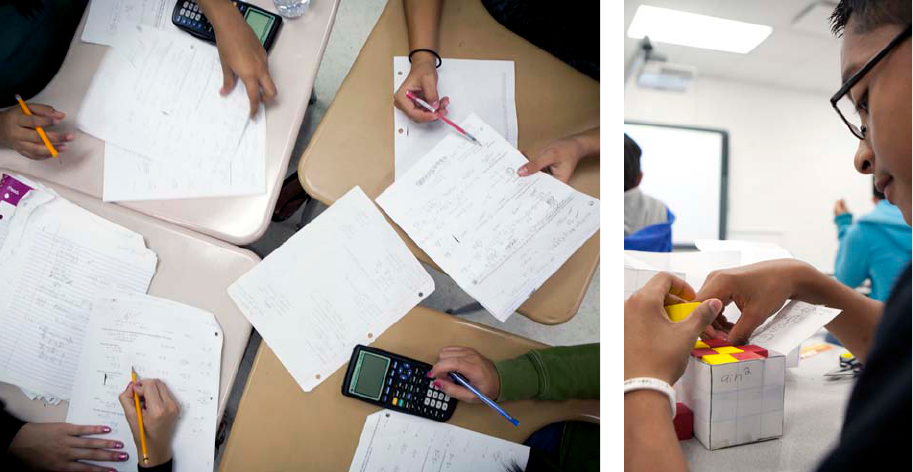
19EDUCATE TEXAS | EARLY COLLEGE | JOBS FOR THE FUTURE COLLEGE-GOING RIGOR IN EVERY CLASSROOM
On one day at PSJA Thomas Jefferson T-STEM Early College, a teacher scaffolded student learning by
asking her class to create Venn diagrams showing the commonalities and differences of two articles. Later,
when the students were asked to write a “compare and contrast” essay, they would be able to draw on this
graphic organizer. In a geography classroom, student groups each compiled information about a religion,
then re-formed groups and taught their new group members about the religion they had researched. A
science class practiced the strategy of Writing to Learn by writing creative stories about “fight or flight”
reactions that incorporated three bodily reactions—an example of writing across the curriculum. Student-
created brochures on surviving college and managing time and stress hang on the classroom walls.
“It’s kind of like a constant thing they explain to us, that they’re getting us ready for college,” said Karina,
a student at PSJA Southwest Early College. “We learn about what you need to do to be able to get into
college.”
“The teachers are very helpful,” said Devany, a student at PSJA North Early College who wants to study
speech therapy and nursing in college. “You really do understand. We do a lot of group work and I think
that’s very good. Instead of them telling us to do this, we’re the ones doing the questions and I really like
that. It’s kind of like we’re taking the lead.”
Teacher Mike Tcheyan would agree that, through the use of the college-ready instructional strategies,
students are taking the lead in many more learning situations. In his chemistry classroom at PSJA Thomas
Jefferson T-STEM one day, he asked students to solve problems and post their answers on the wall. Next, he
gave sticky notes to the rest of the class and had them read the answers, then post notes stating whether
they agreed or disagreed and why. Tcheyan’s students also studied the solubility of gases at different
temperatures, drawing conclusions about why warm soda tastes flat.
“The Common Instructional Framework makes the learning self-directed,” he said:
I’m not standing up there telling them. They’re reading, they’re talking with each other,
and they’re exposing themselves to the material and seeing what they know about it
before we analyze it and come to a conclusion about it. That’s really, really helpful both
on the teaching front and on the kids’ understanding and then being self-directed.
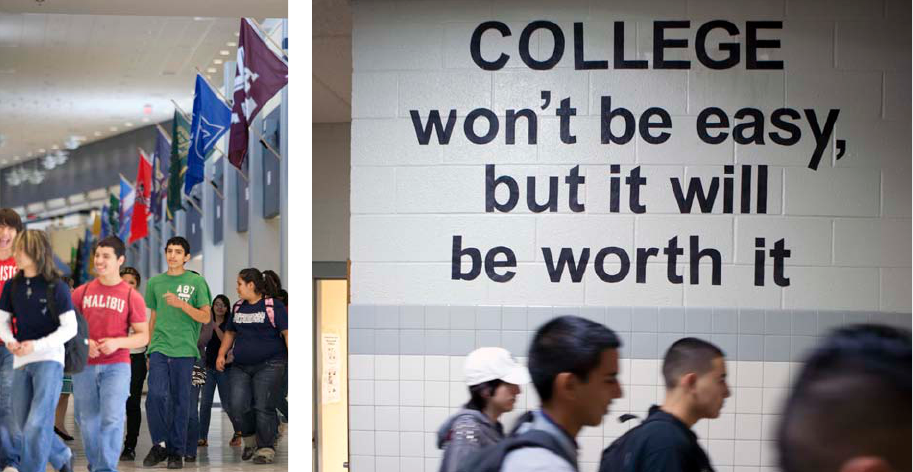
20 LAUNCHING EARLY COLLEGE DISTRICTWIDE: PHARR-SAN JUAN-ALAMO’S “COLLEGE FOR ALL” STRATEGY
S TAY I N G T H E C O U R S E
F
rom the system level to the student level, Pharr-San Juan-Alamo’s strategies are
rooted in visionary leadership, school designs that support early college, and
intensive coaching and support for teachers. College for all continues to spread
in Pharr-San Juan-Alamo. Two traditional high schools are engaged in a planning year
to apply to open early colleges within their buildings in fall 2012, so that all high schools
incorporate the early college concept. In each case, the specifics of the design may vary,
but across all of them, the district’s primary goal is to achieve systemic transformation,
making college pathways the expectation and reality for every student.
Now in its second year of adopting the JFF Common Instructional Framework, the district
is focused on spreading instructional rigor to more schools, and on building internal
capacity so professional development continues after funding for external coaches
is gone. The district is beginning to train elementary school teachers in the Common
Instructional Framework, with plans to spread the model to all 43 schools by summer.
Educate Texas coaches are working with the district to train in-house coaches, some
based at the central office level and others at individual schools. By fall 2012, the district
hopes to have more than 70 internal coaches to help teachers implement strong and
coherent instruction. Through systemic implementation, in which all teachers use a
common language and approach, the vision is to develop students themselves as leaders
of learning who are highly skilled in transferring these college-ready instructional
strategies into learning strategies they can use independently in college.
“Part of this whole strategy is that [King is] always looking at sustainability and scaling,”
said Alma Garcia, Educate Texas’s program officer for early college. “So this is a cost-
effective way of spreading the lessons learned from the schools that were within the
funding source that they had, and how they’ve taken that to a school that has none of
the major funding.”
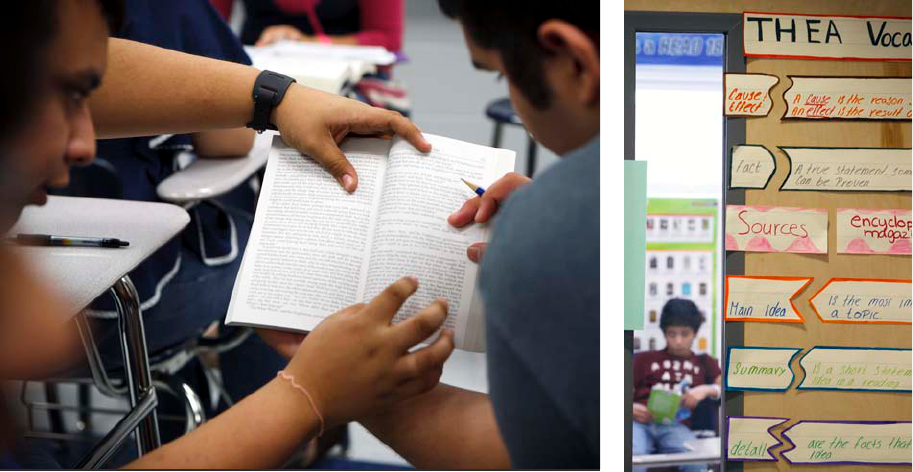
21EDUCATE TEXAS | EARLY COLLEGE | JOBS FOR THE FUTURE STAYING THE COURSE
In addition, Pharr-San Juan-Alamo is starting to leverage and align its districtwide Advanced Placement
initiative, funded by the College Board, with its dual enrollment efforts. If high school students enrolled in
college classes take Advanced Placement exams at the end of the course, they increase their chances of
being able to transfer their college credits earned through South Texas College to private and out-of-state
universities. To that end, the district is piloting an “AP/DC” project at PSJA North that incorporates aspects
of the AP curriculum into dual credit courses.
The district’s next steps in measuring success are to determine the number of students who are on track
to an on-time graduation and the number of students enrolling in college immediately after graduation.
Eventually the district strives to measure college persistence by counting the number of graduates still
enrolled in college after a year, and it also will track the rates of students needing remediation in college.
Finally, the district aspires to build the capacity to track students to the completion of a postsecondary
certificate, Associate’s degree, or Bachelor’s degree.
All these changes, Pharr-San Juan-Alamo’s leaders say, are transforming the culture of the community and
students’ perceptions of what is possible for their future. At Southwest Early College last year, teachers
ran a contest in which groups of ninth graders researched an assigned college. The students reported on
programs of study, admissions requirements, and location and then decorated their classroom door with
that college’s colors. In addition, students filled out sample college applications and learned what goes in a
letter of recommendation.
“You see every door and you’re like, ‘Wow, this college offers you so many things,’” said Sandro, a student
at PSJA Southwest. “It really makes you feel like you want to go to college. I can’t wait.”

22
LAUNCHING EARLY COLLEGE DISTRICTWIDE: PHARR-SAN JUAN-ALAMO’S “COLLEGE FOR ALL” STRATEGY
E N D N O T E S
1
SOURCE: Texas Education Agency Public Education Information Management System
2
For more information, see Allen, Lili and Rebecca E. Wolfe, 2010. Back on Track to
College: A Texas School District Leverages State Policy to Put Dropouts on the Path to
Success. Boston, MA: Jobs for the Future.
3
The Texas Education Agency has developed an early college designation process to ensure
that districts operating early colleges maintain the integrity of the model. This process
includes two levels of designation: designated and provisionally designated. Schools at
least two years old that have addressed all the required design elements are eligible for
designation. Schools that have been operating for less than two years, or schools that are
in the process of fulfilling all the required design elements, are eligible for provisional
designation.

23
EDUCATE TEXAS | EARLY COLLEGE | JOBS FOR THE FUTURE

24
LAUNCHING EARLY COLLEGE DISTRICTWIDE: PHARR-SAN JUAN-ALAMO’S “COLLEGE FOR ALL” STRATEGY


TEL 214.750.4222
5500 Caruth Haven Lane, Dallas, TX 75225-8146
W W W. E DT X .O R G
>> union bug <<
TEL 617.728.4446 FA X 617.728.4857 info@jff.org
88 Broad Street, 8th Floor, Boston, MA 02110
2000 Pennsylvania Avenue, NW, Suite 5300, Washington, DC 20006
W W W. J F F. O R G
